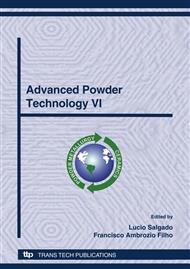p.860
p.865
p.870
p.879
p.885
p.891
p.896
p.902
p.907
Effects of Al2O3 Particles Addition on Compressibility and Sinterability of Aluminium Powder Allows
Abstract:
There is considerable industrial potential for aluminium alloys and aluminium metal matrix composites fabricated via net shape press-and-sintering powder metallurgy using low-cost, elemental premixed powder. In this work, the compressibility and sinterability of premixed Al– 4.5Cu–0.7Si–0.5Mg powder alloy reinforced with Al2O3 particles was analyzed. The powders reinforced with increasing ceramic particle content were cold-pressed under increasing pressure and sintered at 600 oC for 40 minutes, in nitrogen atmosphere. The powders showed the typical compressibility curves and the presence of hard ceramic particles decreased the powder deformation capacity and, consequently, the powder compressibility. The sintering produced swelling of the parts, due to the poor wettability of liquid phase on the aluminium particles and to the Kirkendall effect caused by the difference in diffusivity of aluminium in copper and copper in aluminium. The presence of Al2O3 particles increased the swelling during sintering probably due to the sooner formation of liquid phase.
Info:
Periodical:
Pages:
907-912
Citation:
Online since:
August 2008
Authors:
Price:
Сopyright:
© 2008 Trans Tech Publications Ltd. All Rights Reserved
Share:
Citation:


